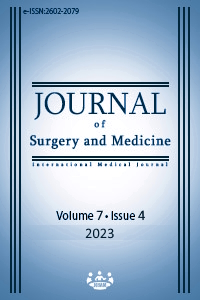Cuffed-tunneled catheters in hemodialysis patients: problems and solution methods: A single-center retrospective cohort study
Cuffed-tunneled catheters
Keywords:
hemodialysis, cuffed-tunneled hemodialysis catheters, catheter thrombosis, patency ratiosAbstract
Background/Aim: Cuffed-tunneled catheter patients encounter various problems during their catheterization period. Early detection and resolution of these problems prolong the life of the catheter. The purpose of the present study was to investigate the problems and solution methods of cuffed-tunneled catheters in hemodialysis patients during their use in light of our experience and literature.
Methods: The study was designed as a retrospective cohort study. Twenty-four months of patient data who had a diagnosis of renal failure and who received cuffed-tunneled hemodialysis catheters between January 2013 and June 21 in the Department of Cardiovascular Surgery of Adiyaman University Faculty of Medicine were analyzed electronically based on the hospital data recording system. The demographic characteristics, localization of the inserted catheter, and duration of catheter use were determined. Primary and secondary patency ratios were calculated and recorded along with the complications in the patients and our treatment approaches to these complications. Finally, the collected data were discussed with reference to the literature data.
Results: The data from 322 cuffed-tunneled catheters were collected in a total of 228 patients during the observation period. It was found that no revision procedure was applied to 73 patients (catheter) during the 24-month period, and a total of 204 revision procedures were applied to 155 patients. The revision procedure consisted of 110 thrombolytic treatments, 64 vein exchanges, 18 tunnel changes, and 12 catheter changes. Primary and secondary patency ratios at 6, 12, 18, and 24 months were calculated as 90.79%, 63.60%, 40.11%, and 32.02% and 96.05%, 89.91%, 72.37%, and 58.33%, respectively. The most common factors that affected primary and secondary patency ratios were determined to be gender (P<0.001 and P=0.056, respectively), body mass index (P<0.001 and P<0.001, respectively) and diabetes mellitus (P=0.018 and P=0.690, respectively).
Conclusion: Thrombolytic treatment is an effective and safe method in catheter thrombosis, which is one of the most important factors rendering the cuffed-tunneled hemodialysis catheters dysfunctional. Also, in tunnel infections, tunnel replacement is a salvage procedure in patients with vascular access problems.
Downloads
References
Raheem A, Rana AI, Mehmood SN, Ramzan M, Shah RA, Naseem S. Two years experience with tunneled dialysis catheters in patients requiring haemodialysis. J Pak Med Assoc. 2014 Jul;64(7):758-61.
Sohail MA, Vachharajani TJ, Anvari E. Central Venous Catheters for Hemodialysis-the Myth and the Evidence. Kidney Int Rep. 2021 Oct 11;6(12):2958-68. DOI: https://doi.org/10.1016/j.ekir.2021.09.009
Wong SS, Kwaan HC, Ing TS. Venous air embolism related to the use of central catheters revisited: with emphasis on dialysis catheters. Clin Kidney J. 2017 Dec;10(6):797-803. DOI: https://doi.org/10.1093/ckj/sfx064
Silverstein DM, Trerotola SO, Clark T, James G, Ng W, Dwyer A, et al; Kidney Health Initiative HDF Workgroup. Clinical and Regulatory Considerations for Central Venous Catheters for Hemodialysis. Clin J Am Soc Nephrol. 2018 Dec 7;13(12):1924-32. DOI: https://doi.org/10.2215/CJN.14251217
Lee T, Mokrzycki M, Moist L, Maya I, Vazquez M, Lok CE; North American Vascular Access Consortium. Standardized definitions for hemodialysis vascular access. Semin Dial. 2011 Sep-Oct;24(5):515-24. DOI: https://doi.org/10.1111/j.1525-139X.2011.00969.x
McGee DC, Gould MK. Preventing complications of central venous catheterization. N Engl J Med. 2003 Mar 20;348(12):1123-33. DOI: https://doi.org/10.1056/NEJMra011883
Beathard GA. Management of bacteremia associated with tunneled-cuffed hemodialysis catheters. J Am Soc Nephrol. 1999 May;10(5):1045-9. DOI: https://doi.org/10.1681/ASN.V1051045
Jinatongthai P, Kongwatcharapong J, Foo CY, Phrommintikul A, Nathisuwan S, Thakkinstian A, Reid CM, Chaiyakunapruk N. Comparative efficacy and safety of reperfusion therapy with fibrinolytic agents in patients with ST-segment elevation myocardial infarction: a systematic review and network meta-analysis. Lancet. 2017 Aug 19;390(10096):747-59. DOI: https://doi.org/10.1016/S0140-6736(17)31441-1
Aurshina A, Hingorani A, Hingorani A, Marks N, Ascher E. Routine use of ultrasound to avert mechanical complications during placement of tunneled dialysis catheters for hemodialysis. J Vasc Surg Venous Lymphat Disord. 2019 Jul;7(4):543-6. DOI: https://doi.org/10.1016/j.jvsv.2018.12.016
Saran R, Li Y, Robinson B, Abbott KC, Agodoa LY, Ayanian J, et al. US Renal Data System 2016 Annual Data Report: Epidemiology of Kidney Disease in the United States. Am J Kidney Dis. 2017 Mar;69(3 Suppl 1):A7-A8. doi: 10.1053/j.ajkd.2016.12.004. Erratum in: Am J Kidney Dis. 2017 May;69(5):712. DOI: https://doi.org/10.1053/j.ajkd.2017.03.001
Hemodialysis Adequacy 2006 Work Group. Clinical practice guidelines for hemodialysis adequacy, update 2006. Am J Kidney Dis. 2006 Jul;48 Suppl 1:S2-90. DOI: https://doi.org/10.1053/j.ajkd.2006.03.051
Wigmore TJ, Smythe JF, Hacking MB, Raobaikady R, MacCallum NS. Effect of the implementation of NICE guidelines for ultrasound guidance on the complication rates associated with central venous catheter placement in patients presenting for routine surgery in a tertiary referral centre. Br J Anaesth. 2007 Nov;99(5):662-5. DOI: https://doi.org/10.1093/bja/aem262
Baskin JL, Pui CH, Reiss U, Wilimas JA, Metzger ML, Ribeiro RC, et al. Management of occlusion and thrombosis associated with long-term indwelling central venous catheters. Lancet. 2009 Jul 11;374(9684):159-69. DOI: https://doi.org/10.1016/S0140-6736(09)60220-8
Wójtowicz D, Cholewa D, Faba AM, Domańska B, Kokoszka J, Kopacz K, et al. Diabetes decreases patency of tunneled catheters in hemodialysis patients after first effective thrombolysis with urokinase. Ren Fail. 2018 Nov;40(1):384-9. DOI: https://doi.org/10.1080/0886022X.2018.1487856
Shrestha KR, Gurung D, Shrestha UK. Outcome of Cuffed Tunneled Dialysis Catheters for Hemodialysis Patients at a Tertiary Care Hospital: A Descriptive Cross-sectional Study. JNMA J Nepal Med Assoc. 2020 Jun 30;58(226):390-5. DOI: https://doi.org/10.31729/jnma.4795
Sethi J, Gaur M, Rathi M, Kohli HS. Tunneled Femoral Vein Catheterization for Long-term Hemodialysis - Experience from a Tertiary Care Center. Indian J Nephrol. 2022 Jul-Aug;32(4):371-4. DOI: https://doi.org/10.4103/ijn.ijn_224_21
Porazko T, Hobot J, Ziembik Z, Klinger M. Tunnelled Haemodialysis Catheter Removal: An Underappreciated Problem, Not Always Simple and Safe. Int J Environ Res Public Health. 2020 Apr 27;17(9):3027. DOI: https://doi.org/10.3390/ijerph17093027
Downloads
- 560 797
Published
Issue
Section
How to Cite
License
Copyright (c) 2023 Mümtaz Murat Yardımcı, Cengiz Güven
This work is licensed under a Creative Commons Attribution-NonCommercial-NoDerivatives 4.0 International License.
















